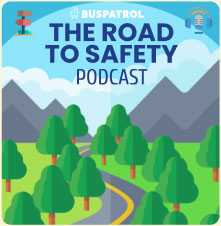Key takeaways:
- Our partners are using program data to drive education, guide strategic planning, and make smarter safety decisions that keep students safer on the road.
- In Buffalo, city leaders leveraged violation data to launch a public awareness campaign with digital message boards in high-risk areas. Together with enforcement, this effort helped reduce weekly violations by about 33 percent.
- Albany County is using revenue from stop-arm violation tickets to fund a new driver education program, covering teacher certification and class costs for students.
- In Pittsburgh, violation data helped the district relocate high-risk bus stops to safer nearby streets, improving safety for students in those areas.
At BusPatrol, we’re proud to be America’s most trusted and deployed school bus stop-arm safety program. Across the country, our technology helps communities curb illegal school bus passings and protect children on their way to and from school.
However, detecting illegal passings is just one piece of the puzzle. Each violation captured through our technology offers valuable insight into driver behavior and community risk. While BusPatrol programs consistently show a decrease in illegal passings after launch, automated stop-arm enforcement is most effective when it’s part of a broader, community-wide approach to transportation safety. That means pairing enforcement with public education, thoughtful infrastructure planning, and collaboration across local agencies.
Leveraging violation data, the communities we serve can better understand where risks exist and how to prevent them before they lead to tragedy. And in places like Albany County, Buffalo, and Pittsburgh, our partners are turning that data into real, lasting impact.
Albany County: Reinvesting Enforcement Revenue in Driver Education
Every day in New York, an estimated 50,000 drivers illegally pass stopped school buses, putting children’s lives at risk. To help change that, South Colonie Central School District became the first in Albany County to equip its buses with our AI-powered stop-arm cameras and safety program.
“Tragically, kids have been injured and even killed by people who are breaking the law,” said Albany County Executive Dan McCoy. “This has to stop, and this program will help us do that.”
Since launching, the program has captured thousands of violations, giving leaders a clear picture of when and where dangerous driving happens. Building on that insight, the city used the revenue generated from drivers who were ticketed for illegally passing a school bus to fund a new driver’s education program, covering teacher certifications and student class costs to help build safer, more informed drivers.
As Superintendent Dr. David Perry explained, “Bringing back driver’s education within our schools not only provides safer drivers and better education, it provides long-lasting impact on our communities.”
By turning fines into funding for education, Albany County is proving how enforcement can fuel prevention efforts and strengthen a community’s commitment to road safety.
Pittsburgh: Using Data to Relocate High-Risk Bus Stops
In Pittsburgh, data didn’t just reveal where violations were happening — it helped shape a safer route for students.
BusPatrol violation data revealed that two bus stop locations along Fifth Avenue — 5800 Block of Fifth Ave (Fifth Ave and Maryland) and 5300 Block of Fifth Ave (Fifth Ave and Aiken) — consistently ranked among the top five hotspots for illegal passings. These were spots where students regularly got on and off the bus, making the high number of violations especially concerning.
Using this insight, the district decided to relocate those bus stops to nearby streets with lower traffic and better visibility. The new stop locations at 400 Block of S. Highland Ave, 5800 Block of Walnut St, and 900 Block of Aiken Ave have already seen significantly fewer violations since the change and are no longer considered violation hot spots.
This simple shift shows how an AI-powered enforcement program can do more than help enforce the law. By pinpointing high-risk locations and making strategic changes, the district made the area safer for students and drivers.
Buffalo: Turning Violation Data into Community Awareness
Our partners in Buffalo took a different route, using education alongside enforcement to make sure drivers couldn’t ignore the law.
During the first year of the city’s school bus safety program, cameras recorded nearly 40,000 drivers illegally passing stopped school buses, highlighting how common and dangerous the problem had become.
When officials reviewed the data, several violation hotspots stood out, including Broadway and Fillmore, Bailey and Delavan, and Main and Amherst. These patterns helped the city pinpoint where drivers were most likely to make risky decisions and where education efforts could have the biggest impact.
The city’s answer was a public awareness campaign focused on education and visibility. Digital message boards were installed in these high-violation areas to remind motorists to stop when school bus lights are flashing and to stay alert for children crossing the street.
 By the end of the school year, weekly violations had dropped by roughly 33%, showing how pairing enforcement with consistent reminders and community outreach can help change driver behavior.
By the end of the school year, weekly violations had dropped by roughly 33%, showing how pairing enforcement with consistent reminders and community outreach can help change driver behavior.
As BusPatrol Senior Vice President Ryan Monell explained, “Each ticket is a reminder to tell folks to slow down and be aware for a school bus. When the lights are flashing, a child is probably getting off that bus and could be crossing the street.”
A Shared Commitment to Safer Communities
Communities like Albany County, Buffalo, and Pittsburgh are proving that the real power of technology is in what it makes possible: greater awareness, stronger education, and safer streets for kids.
When data and education work hand in hand, enforcement becomes a catalyst for change. Want to see this impact in your community? Learn more about partnering with BusPatrol.


